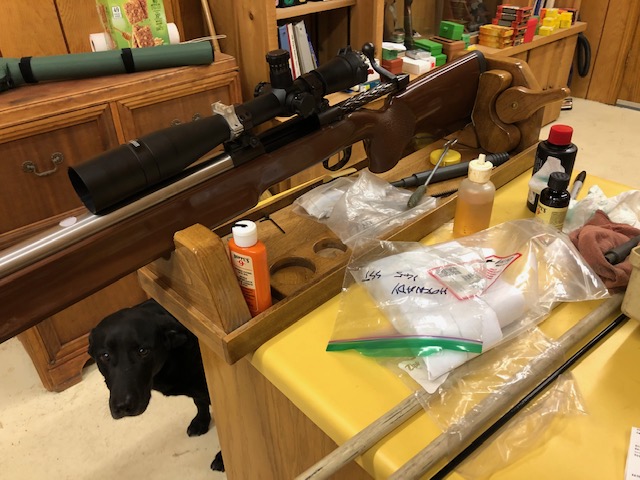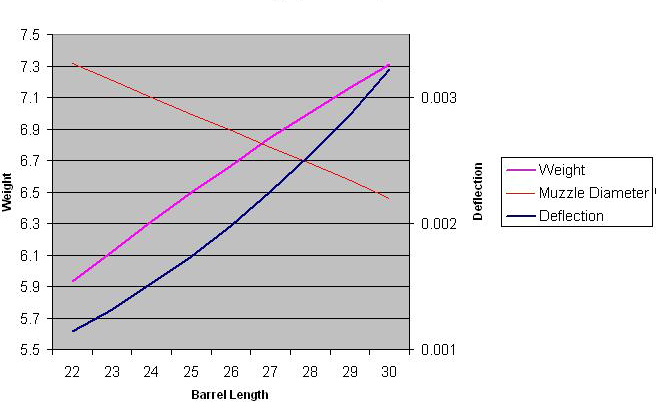The Ideal Barrel for a .308 Tactical Rifle
January 23, 2015 2:39 am(This article was originally published in Tactical Shooter magazine. The editor comment is from Dave Brennan.) Editor: Recently a TS subscriber wrote to us, looking for some guidance on the barrel contour selection for a .308 chambered tactical rifle. We felt that the inquiry was a bit too broad-based in topic matter and while a scholarly discourse in depth might have been nice… to do the job properly would have taken perhaps a dozen pages… and been a rather dry reading dozen pages at that. Since we live in a “Be practical” type of world, we fired off a “Help!” missive to Dan Lilja, the honcho at Lilja Precision Rifle Barrels (P.O.Box 372, Plains, MT, phone (406) 826-3084), together with a cover letter that mused… “I’m looking for a good, technically-oriented response… but not a rewrite of Gone With The Wind “. The goodfellow, Heaven bless him, must have understood what I was trying to say… because his response was along just the very lines that I was looking for. The editor considers Dan Lilja one of the most knowledgeable of today’s authorities on long range rifle shooting.
To make a recommendation for a .308 caliber barrel to be installed on a Remington 700 action, there are a couple of questions that need to be addressed. The first question is overall rifle weight. For most tactical applications, a rifle in the 10-12 pound range is about right. This rifle weight allows a reasonably heavy barrel for good accuracy, but is not cumbersome when the shooter needs to make a quick entry or exit or a long stalk. And it is hefty enough to hold fairly steady.

Secondly, we’ll look at both bullet selection and barrel contour/length in making a recommendation for a barrel twist rate and profile.
Using the .308 Winchester for a tactical situation, I would like to use a bullet in the 150-180 grain weight range. For longer range shooting, say out to 600 yards, a high ballistic coefficient is desirable to help offset the shooter’s margin of error in estimating wind drift and, if not using a laser range finder, range estimation. With the lower velocities of the 308 Winchester cartridge though, the heavier bullets, with the high ballistic coefficient, tend to be a little too heavy, in my opinion. This extra weight keeps the muzzle velocity down. So a compromise of reasonable muzzle velocities and ballistic coefficient is necessary. The .308 just lacks the horsepower for truly long-range shooting. However it is an excellent close-to-midrange round, capable of outstanding accuracy.
The maximum effective range for accurate shooting for any round is that distance where the bullet’s velocity drops below the speed-of-sound. Depending on the atmospheric conditions, that velocity is near 1120 fps. The 168 grain Sierra Match King is an excellent bullet in the 308 Winchester, and is probably my first choice for the shooting situation we’re discussing in this article. This bullet has a ballistic coeficient of .475 and with a barrel of 26″ or so, a velocity of 2800 fps is reasonable. Using these numbers in an exterior ballistics program, we find that this bullet will go subsonic past 1100 yards. If we were to go to a lighter bullet, like the 150 grain Sierra Match King, with a lower ballistic coefficient of about .440 and a muzzle up to 2900 fps, our supersonic range is no better. Individual rifles and longer barrel lengths will improve on these numbers, but the 308 Winchester is never going to be a 1000 yard powerhouse.
So, if we’re going to settle on the 168 grain Sierra Match King or another bullet of a similar weight and style, then a 12″ twist rate is the best choice. To keep the velocity up, yet keep the rifle handy, I’d opt for a barrel length in the 26-27″ range.
Now the selection for a barrel contour needs to be made. We’ve made a number of barrels for Robar; a company which specializes in rifles of this type. The cover of the January, 2000 issue of Tactical Shooter shows one of Robar’s SR-60 rifles. This special contour that we make for Robar weighs about 5 pounds in a non-fluted condition. It is similar to the contour found on the Remington Police Special rifles and our standard #7 contour. The barrel has enough diameter to remain stiff, and accuracy is excellent. I like this contour for a tactical rifle.
If it is desirable to make the rifle a little heavier, then I would suggest using one of the straight taper barrels, like the NBRSA Heavy Varmint classification or a close variation. We’ve made .30 caliber barrels like this for the Navy SEALS, theirs being a little lighter than the Heavy Varmint taper just mentioned. Finish lengths again would be in the 26-27″ range. If we stepped up to a cartridge like the .300 Winchester, I’d consider going to a 30″ length.
Some readers might wonder why I wouldn’t suggest going even longer than 30″, and there are a couple of reasons why not. One of the primary reasons goes back to our already mentioned requirement for portability. A long barrel just seems to always get in the way, banging against whatever obstacle there might be.
Another good reason is rifle balance. As the barrel gets longer the center of gravity moves forward, tending to make the rifle more and more muzzle-heavy. The rifle can be easily counter-balanced by making the stock heavier, especially in the butt area, but in doing so the overall weight of the rifle becomes higher. Also, too much barrel weight on a lighter-weight repeater action, like our preselected Remington 700, can affect the bedding and create problems that wouldn’t exist with a shorter barrel. It is not unusual to see vertical grouping in a long-barreled, muzzle-heavy rifle. A maximum barrel length of 30″ seems to be a good compromise.
There is one more good reason to stay with a 26-30″ barrel, and that has to do with barrel stiffness. As a barrel gets longer it becomes more limber. The most accurate barrels are the stiffest, all other factors being equal. Increasing the diameter of a barrel has the opposite effect, making a barrel more rigid. But there is a weight penalty in going too large in diameter. If we take a look at the math involved in calculating the rigidity of a rifle barrel it can be modeled after the classic cantilevered beam. For a round beam, like a barrel, its rigidity increases with the 4th power of its diameter but decreases with the 3rd power of its length. The basic formula for calculation of muzzle deflection is:
D = (W*l^3)/3*E*Ix
Where: D is the deflection at the muzzle in inches, W is the force or load applied at the muzzle in pounds, l is the free length of the barrel in inches (not including threads), E is the modulus of elasticity or Young’s modulus for the barrel material, and Ix is the moment of inertia for the barrel.
In plain English this translates into shorter lengths and bigger diameters being stiffer, and as we know, stiffness and accuracy are closely married. Like actual married life there are always trade-offs. Long barrel length means higher velocity but it also means lower stiffness values. Diameters that are bigger mean greater stiffness but the extra weight isn’t always desirable. My wife has told me I can be stiff-necked but that isn’t always desirable either.
Fluting a barrel helps with the compromise though. A fluted barrel retains most of the stiffness gained by increasing diameter, yet reduces the weight gain. And as a side benefit, fluting also increases the cooling rate of a barrel by exposing more surface area to the air.
I ran some numbers through a computer program I developed that calculates barrel weights and stiffness values. In this example I used the NBRSA Heavy Varmint taper. For those not familiar with this profile, it is dimensioned as 1.250″ at the chamber end for 5″. It then begins a straight taper to .900″ at 29″, a taper of .0146″ per inch. In the examples below we’ll start with a 22″ barrel and go on out to 30″. The table will show the weight for each barrel length, the deflection of the muzzle if a one-pound load were applied perpendicular to the bore centerline, and the diameter of the muzzle at the specified length. In all cases the model is for a .308″ caliber barrel.
.308″ caliber NBRSA Heavy Varmint taper barrel stiffness versus length table
| Barrel length in inches | Weight in Pounds & ounces | delfection in inches | muzzle diameter in inches |
| 22″ | 5-14.9 | .001143″ | 1.002″ |
| 23″ | 6-2.0 | .001321″ | .987″ |
| 24″ | 6-5.0 | .001520″ | .973″ |
| 25″ | 6-7.9 | .001740″ | .958″ |
| 26″ | 6-10.7 | .001983″ | .944″ |
| 27″ | 6-13.5 | .002251″ | .929″ |
| 28″ | 7-0.1 | .002546″ | .915″ |
| 29″ | 7-2.6 | .002869″ | .900″ |
| 30″ | 7-5.0 | .003223″ | .885″ |
So, we can calculate from the above that a 30″ long Heavy Varmint taper barrel will deflect 182% more than a 22″ long barrel will. The difference in length between these two barrels is just 36% and the weight increased just 23%, going from the 22″ to the 30″ barrel. The point is: increasing the length of a barrel quickly decreases its stiffness.

This graph was added in October of 2004 and was provided by Rick. It demonstrates the same information as the table above but in graph form.
Our experience has shown that for a .308 caliber tactical rifle with the overall rifle weight and shooting distances mentioned earlier, a barrel of 24-27″ is optimum in one of the fairly heavy contours we discussed. Closer ranges or other considerations might dictate a shorter barrel. The vast majority of the barrels we make for the professionals, who have made their own decisions on barrel length and profile, also fall into these same parameters.
(As of February of 2004 we have added a new straight taper to our list of standards that we refer to as the Tactical. It was developed by one of our military customers. It is a 1.200″ diameter cylinder for 4″ and then a straight taper to .800″ at 26″. The weight at this length is 5.55 pounds in .30 caliber.)

